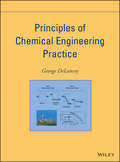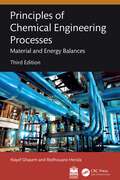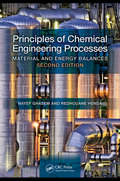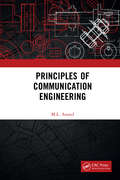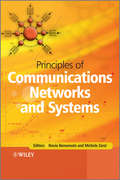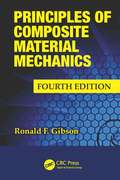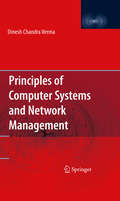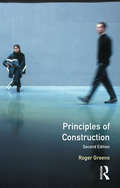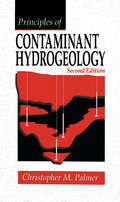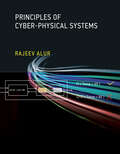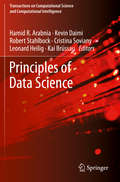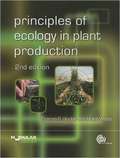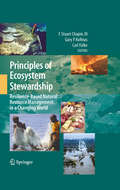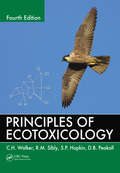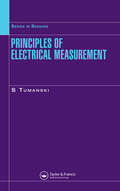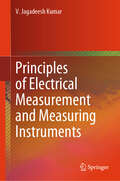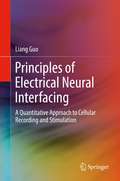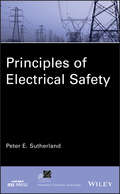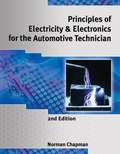- Table View
- List View
Principles of Chemical Engineering Practice
by George DelanceyEnables chemical engineering students to bridge theory and practiceIntegrating scientific principles with practical engineering experience, this text enables readers to master the fundamentals of chemical processing and apply their knowledge of such topics as material and energy balances, transport phenomena, reactor design, and separations across a broad range of chemical industries. The author skillfully guides readers step by step through the execution of both chemical process analysis and equipment design.Principles of Chemical Engineering Practice is divided into two sections: the Macroscopic View and the Microscopic View. The Macroscopic View examines equipment design and behavior from the vantage point of inlet and outlet conditions. The Microscopic View is focused on the equipment interior resulting from conditions prevailing at the equipment boundaries. As readers progress through the text, they'll learn to master such chemical engineering operations and equipment as:Separators to divide a mixture into parts with desirable concentrationsReactors to produce chemicals with needed propertiesPressure changers to create favorable equilibrium and rate conditionsTemperature changers and heat exchangers to regulate and change the temperature of process streamsThroughout the book, the author sets forth examples that refer to a detailed simulation of a process for the manufacture of acrylic acid that provides a unifying thread for equipment sizing in context. The manufacture of hexyl glucoside provides a thread for process design and synthesis.Presenting basic thermodynamics, Principles of Chemical Engineering Practice enables students in chemical engineering and related disciplines to master and apply the fundamentals and to proceed to more advanced studies in chemical engineering.
Principles of Chemical Engineering Processes: Material and Energy Balances
by Nayef Ghasem Redhouane HendaPrinciples of Chemical Engineering Processes: Material and Energy Balances continues to serve an essential text, guiding students on the basic principles and calculation techniques used in the field of chemical engineering and providing a solid understanding of the fundamentals of the application of material and energy balances. This third edition has been updated to reflect advances in the field and feedback from professors and students. Packed with illustrative examples and case studies, this book:• Features learning objectives and homework problems in every chapter, new material on software modeling, and additional and enhanced solved examples and problems.• Discusses problems in material and energy balances related to chemical reactors and explains the concepts of dimensions, units, psychrometry, steam properties, and conservation of mass and energy.• Demonstrates how Python, MATLAB®, and Simulink® can be used to solve complicated problems of material and energy balances, and now features an introduction to the basics of building Simulink models.• Demonstrates how Python and its libraries, such as NumPy and SciPy, can be used to solve complex problems in material and energy balances, and introduces the basics of building models using Python frameworks similar to Simulink.• Shows how to solve steady-state and transient mass and energy balance problems involving multiple-unit processes and recycle, bypass, and purge streams.• Develops quantitative problem-solving skills, specifically the ability to think quantitatively (including numbers and units), the ability to translate words into diagrams and mathematical expressions, the ability to use common sense to interpret vague and ambiguous language in problem statements, and the ability to make judicious use of approximations and reasonable assumptions to simplify problems.• Offers educational software and sample tutorials and quizzes for download.Aimed at both chemical engineering students and professionals, this book helps readers understand how to calculate, manage, and apply the key ideas of material and energy use in chemical processes through real-world examples. Lecture slides and a solutions manual are available with qualifying course adoption.
Principles of Chemical Engineering Processes: Material and Energy Balances, Second Edition
by Nayef Ghasem Redhouane HendaPrinciples of Chemical Engineering Processes: Material and Energy Balances introduces the basic principles and calculation techniques used in the field of chemical engineering, providing a solid understanding of the fundamentals of the application of material and energy balances. Packed with illustrative examples and case studies, this book:Discuss
Principles of Chemical Separations with Environmental Applications
by Richard D. Noble Patricia A. TerryThis introduction to chemical separations technology presents the chemical and/or physical basis of different techniques and explains how to evaluate them for design and analysis. Chemical separations are of central importance in many areas of environmental science, whether it is cleaning up polluted water or soil, the treatment of discharge streams from chemical processes, or modification of a specific process to decrease its environmental impact. This textbook is suitable for undergraduate and graduate students taking courses on environmental separations or environmental engineering. Many worked examples and over 100 homework problems are key highlights.
Principles of Cognitive Radio
by Ezio BiglieriWidely regarded as one of the most promising emerging technologies for driving the future development of wireless communications, cognitive radio has the potential to mitigate the problem of increasing radio spectrum scarcity through dynamic spectrum allocation. Drawing on fundamental elements of information theory, network theory, propagation, optimisation and signal processing, a team of leading experts present a systematic treatment of the core physical and networking principles of cognitive radio and explore key design considerations for the development of new cognitive radio systems. Containing all the underlying principles you need to develop practical applications in cognitive radio, this book is an essential reference for students, researchers and practitioners alike in the field of wireless communications and signal processing.
Principles of Communication Engineering
by M.L. AnandThis is the book, in which the subject matter is dealt from elementary to the advance level in a unique manner. Three outstanding features can be claimed for the book viz. (i) style; the student, while going through the pages would feel as if he is attending a class room. (ii) language: that an average student can follow and (iii) approach: it takes the student from ''known to unknown'' and ''simple to complex.'' The book is reader friendly, thought provoking and stimulating. It helps in clearing cobwebs of the mind. The style is lucid and un-adulterated. Unnecessary mathematics has been avoided. Note: T&F does not sell or distribute the Hardback in India, Pakistan, Nepal, Bhutan, Bangladesh and Sri Lanka.
Principles of Communications Networks and Systems
by Nevio Benvenuto Michele ZorziAddressing the fundamental technologies and theories associated with designing complex communications systems and networks, Principles of Communications Networks and Systems provides models and analytical methods for evaluating their performance. Including both the physical layer (digital transmission and modulation) and networking topics, the quality of service concepts belonging to the different layers of the protocol stack are interrelated to form a comprehensive picture.The book is designed to present the material in an accessible but rigorous manner. It jointly addresses networking and transmission aspects following a unified approach and using a bottom up style of presentation, starting from requirements on transmission links all the way up to the corresponding quality of service at network and application layers. The focus is on presenting the material in an integrated and systematic fashion so that students will have a clear view of all the principal aspects and of how they interconnect with each other.A comprehensive introduction to communications systems and networks, addressing both network and transmission topicsStructured for effective learning, with basic principles and technologies being introduced before more advanced ones are explainedFeatures examples of existing systems and recent standards as well as advanced digital modulation techniques such as CDMA and OFDMContains tools to help the reader in the design and performance analysis of modern communications systemsProvides problems at the end of each chapter, with answers on an accompanying website
Principles of Composite Material Mechanics (Mechanical Engineering Series)
by Ronald F. GibsonPrinciples of Composite Material Mechanics covers a unique blend of classical and contemporary mechanics of composites technologies. It presents analytical approaches ranging from the elementary mechanics of materials to more advanced elasticity and finite element numerical methods, discusses novel materials such as nanocomposites and hybrid multis
Principles of Computer Systems and Network Management
by Dinesh Chandra VermaSystems Management is emerging as the predominant area for computer science in the enterprise, with studies showing that the bulk (up to 80%) of an enterprise IT budget is spent on management/operational issues and is the largest piece of the expenditure. This textbook provides an overview of the field of computer systems and network management. Systems management courses are being taught in different graduate and undergraduate computer science programs, but there are no good books with a comprehensive overview of the subject. This text book will provide content appropriate for either an undergraduate course (junior or senior year) or a graduate course in systems management.
Principles of Construction
by Roger GreenoPrinciples of Construction is an illustrated guide to the processes involved in a building programme, from inception stage through to completion. This second edition has been updated in accordance with current Building Regulation, with the emphasis remaining on safety and the correct use of materials.Following a logical procession of concepts and practice, the book includes details of the various aspects of elementary construction and offers an insight into the techniques applied in larger scale projects using standard steel sections and reinforced concrete. Other procedures covered include undertaking a structural survey, recognising structural defects and carrying out remedial treatment.
Principles of Contaminant Hydrogeology
by Christopher M. PalmerThis second edition features new and expanded coverage of contaminant hydrogeologic investigations. It presents a practical approach to completing investigations for environmental compliance, emphasizing the use of geologic principles in assessment to move sites toward cleanup. Stressing the basics of collecting data that can withstand regulatory scrutiny and achieve remediation, Principles of Contaminant Hydrogeology, Second Edition demonstrates how to solve a client's site contamination problem while maximizing cost effectiveness. It focuses on small- and medium-sized firms, for which speed, accuracy, and cost are all crucial factors in the site assessment and closure process. Based on "real world" problems, the book takes you step-by-step through the investigation and includes client-consultant-regulator interaction, budgets, ethics, and data extrapolation for solving problems. It introduces concepts such as field logistics, drilling techniques, sampling protocols, contaminant movement, and remediation. Regulatory personnel, hydrogeological consultants, drilling contractors, remediation contractors, university instructors, and students will benefit from the wealth of information provided in this new edition.
Principles of Cyber-Physical Systems
by Rajeev AlurA foundational text that offers a rigorous introduction to the principles of design, specification, modeling, and analysis of cyber-physical systems.A cyber-physical system consists of a collection of computing devices communicating with one another and interacting with the physical world via sensors and actuators in a feedback loop. Increasingly, such systems are everywhere, from smart buildings to medical devices to automobiles. This textbook offers a rigorous and comprehensive introduction to the principles of design, specification, modeling, and analysis of cyber-physical systems. The book draws on a diverse set of subdisciplines, including model-based design, concurrency theory, distributed algorithms, formal methods of specification and verification, control theory, real-time systems, and hybrid systems, explaining the core ideas from each that are relevant to system design and analysis.The book explains how formal models provide mathematical abstractions to manage the complexity of a system design. It covers both synchronous and asynchronous models for concurrent computation, continuous-time models for dynamical systems, and hybrid systems for integrating discrete and continuous evolution. The role of correctness requirements in the design of reliable systems is illustrated with a range of specification formalisms and the associated techniques for formal verification. The topics include safety and liveness requirements, temporal logic, model checking, deductive verification, stability analysis of linear systems, and real-time scheduling algorithms. Principles of modeling, specification, and analysis are illustrated by constructing solutions to representative design problems from distributed algorithms, network protocols, control design, and robotics.This book provides the rapidly expanding field of cyber-physical systems with a long-needed foundational text by an established authority. It is suitable for classroom use or as a reference for professionals.
Principles of Cyber-Physical Systems: An Interdisciplinary Approach
by Sajal K. Das Sandip RoyThis unique introduction to the foundational concepts of cyber-physical systems (CPS) describes key design principles and emerging research trends in detail. Several interdisciplinary applications are covered, with a focus on the wide-area management of infrastructures including electric power systems, air transportation networks, and health care systems. Design, control and optimization of cyber-physical infrastructures are discussed, addressing security and privacy issues of networked CPS, presenting graph-theoretic and numerical approaches to CPS evaluation and monitoring, and providing readers with the knowledge needed to operate CPS in a reliable, efficient, and secure manner. Exercises are included. This is an ideal resource for researchers and graduate students in electrical engineering and computer science, as well as for practitioners using cyber-physical systems in aerospace and automotive engineering, medical technology, and large-scale infrastructure operations.
Principles of Data Science (Transactions on Computational Science and Computational Intelligence)
by Hamid R. Arabnia Robert Stahlbock Kevin Daimi Cristina Soviany Leonard Heilig Kai BrüssauThis book provides readers with a thorough understanding of various research areas within the field of data science. The book introduces readers to various techniques for data acquisition, extraction, and cleaning, data summarizing and modeling, data analysis and communication techniques, data science tools, deep learning, and various data science applications. Researchers can extract and conclude various future ideas and topics that could result in potential publications or thesis. Furthermore, this book contributes to Data Scientists’ preparation and to enhancing their knowledge of the field. The book provides a rich collection of manuscripts in highly regarded data science topics, edited by professors with long experience in the field of data science.Introduces various techniques, methods, and algorithms adopted by Data Science expertsProvides a detailed explanation of data science perceptions, reinforced by practical examplesPresents a road map of future trends suitable for innovative data science research and practice
Principles of Data Transfer Through Communications Networks, the Internet, and Autonomous Mobiles
by Izhak RubinUnderstand the principles and practical basis of global telecommunications and data communications networks with this essential text Our increasingly connected world is more reliant than ever on data transport and the communication networking technologies of the moment. Ever-expanding wireless communications and the Internet of Things have brought connectivity into more areas of our lives than ever before. Virtually every workplace and industry is now reliant at some level on data transfer. Principles of Data Transfer through Communications Networks, the Internet, and Autonomous Mobiles offers a comprehensive yet accessible overview of the principles and methods of computer communications and mobile wireless network systems. It’s designed to equip a vast range of students and professionals with the necessary toolkit to manage data flows between and across network systems at various scales. Drawing upon decades of teaching and practical experience, it’s a must-own resource for anyone looking to understand the core mechanics that power our world of mass communications. Readers will also find: Coverage of cutting-edge technologies such as autonomous vehicular highways that draw upon novel communications technologiesDetailed discussion of design and performance behavior for major communication networking technologiesTreatment designed for readers with no prior knowledge of computer science or programming Principles of Data Transfer through Communications Networks, the Internet, and Autonomous Mobiles is ideal for students in data communications, telecommunications and wireless networking technology courses, as well as professionals working in data communications industries or those who make use of data transfer communications networks as part of their work.
Principles of Digital Communication
by Robert G. GallagerThe renowned communications theorist Robert Gallager brings his lucid writing style to the study of the fundamental system aspects of digital communication for a one-semester course for graduate students. With the clarity and insight that have characterized his teaching and earlier textbooks, he develops a simple framework and then combines this with careful proofs to help the reader understand modern systems and simplified models in an intuitive yet precise way. A strong narrative and links between theory and practice reinforce this concise, practical presentation. The book begins with data compression for arbitrary sources. Gallager then describes how to modulate the resulting binary data for transmission over wires, cables, optical fibers, and wireless channels. Analysis and intuitive interpretations are developed for channel noise models, followed by coverage of the principles of detection, coding, and decoding. The various concepts covered are brought together in a description of wireless communication, using CDMA as a case study.
Principles of Digital Communication and Coding (Dover Books on Electrical Engineering)
by Jim K. Omura Andrew J. ViterbiWritten by two distinguished experts in the field of digital communications, this classic text remains a vital resource three decades after its initial publication. Its treatment is geared toward advanced students of communications theory and to designers of channels, links, terminals, modems, or networks used to transmit and receive digital messages.The three-part approach begins with the fundamentals of digital communication and block coding, including an analysis of block code ensemble performance. The second part introduces convolutional coding, exploring ensemble performance and sequential decoding. The final section addresses source coding and rate distortion theory, examining fundamental concepts for memoryless sources as well as precepts related to memory, Gaussian sources, and universal coding. Appendixes of useful information appear throughout the text, and each chapter concludes with a set of problems, the solutions to which are available online.
Principles of Ecology in Plant Production
by Thomas Sinclair Albert Weiss Franklin GardnerProduction of food fibre and fuel is vital for humanity, and as the world population continues to rise, demands on these resources is ever increasing. In a context of growing worldwide concern about sustainability and environmental impacts of cropland, grassland and forestry practices, this textbook provides an introduction to the processes that define the ecology and environment of plant production. Core principles are examined such as soil-plant relationships, genetic manipulation and diversity, yield and water requirements, as well as physical factors such as solar radiation, temperature and weather. Fully updated with new chapters on climate change and biofuels, this edition is an important text for students and researchers in agronomy, forestry, botany, ecology and environmental sciences. Praise for the first edition: 'I highly recommend this book for undergraduate students in plant production courses. It is easy to read, well-structured and of high scientific level...also useful for a more general readership' Scientia Horticulturae
Principles of Ecosystem Stewardship
by Gary P. Kofinas M. C. Chapin F. Stuart Chapin III Carl FolkeThis is a textbook for Natural Resource Management, Resource Conservation and Ecosystem Management, as well as other related or more specialized courses. Most textbooks on natural resource and ecosystem management are dominated by a steady-state view that interprets change as gradual and incremental and disregards interactions across scales. Management implementation of steady-state theory and policies tends to invest in controlling a few selected ecosystem processes, at the expense of long-term social-ecological resilience - i.e., the capacity of the system to cope with surprise and abrupt changes. Loss of resilience makes systems more vulnerable to both expected and unforeseen changes. Achieving desirable outcomes for humanity, such as those of the UN Millennium Development Goals on poverty, food security, and environmental sustainability, will require new integrated and adaptive approaches to social and economic development, where the complex interconnectedness between humans and nature, at all scales, is considered and the existence of uncertainty and surprise accepted as the rule. The purpose of this textbook is to provide a new framework for resource management - a framework based on the necessity of managing resources in a world dominated by uncertainty and change. The book links recent advances in the theory of resilience, sustainability, and vulnerability with practical issues of resource management.
Principles of Ecotoxicology
by C.H. Walker R.M. Sibly D.B. PeakallCutting across traditional subject boundaries, Principles of Ecotoxicology, Fourth Edition gives readers an integrated view of ecotoxicology, from molecules to ecosystems. This new edition of a bestselling textbook continues to emphasize principles rather than practice, providing the interdisciplinary perspective and grounding required for research
Principles of Electrical Measurement
by Slawomir TumanskiThe field of electrical measurement continues to grow, with new techniques developed each year. From the basic thermocouple to cutting-edge virtual instrumentation, it is also becoming an increasingly "digital" endeavor. Books that attempt to capture the state-of-the-art in electrical measurement are quickly outdated. Recognizing the need for a tex
Principles of Electrical Measurement and Measuring Instruments
by V. Jagadeesh KumarThis book covers the topics in Electrical and Electronic Measurements at the undergraduate and postgraduate levels. Most universities prescribe a compulsory course covering these topics at the undergraduate level. The book also covers advanced concepts taught in postgraduate degree programme in Instrumentation. The book is a &‘Textbook&’ for an undergraduate degree program in Electrical, Electronics, Control and Instrumentation engineering.
Principles of Electrical Neural Interfacing: A Quantitative Approach to Cellular Recording and Stimulation
by Liang GuoThis textbook fills a gap to supply students with the fundamental principles and tools they need to perform the quantitative analyses of the neuroelectrophysiological approaches, including both conventional and emerging ones, prevalently used in neuroscience research and neuroprosthetics. The content grows out of a course on Neuroengineering and Neuroprosthetics, which the author has taught already several times. The key problems the author addresses include (1) the universal operating mechanisms of neuroelectrophysiological approaches, (2) proper configuration of each approach, and (3) proper interpretation of the resulting signals. Efforts are made both to extract the universal principles underlying this common class of approaches and discern the unique properties of each individual approach. To address these important problems, equivalent electrical circuit modeling and signal analysis are used to unravel the functioning mechanisms and principles and provide sound interpretations to the associated signals and phenomena. This book aims to derive analytical solutions to these equivalent circuits, which can offer clear and complete mechanistic insights to the underlying biophysics.
Principles of Electrical Safety (IEEE Press Series on Power Engineering)
by Peter E. SutherlandPrinciples of Electrical Safety discusses current issues in electrical safety, which are accompanied by series' of practical applications that can be used by practicing professionals, graduate students, and researchers. . <P><P>* Provides extensive introductions to important topics in electrical safety * Comprehensive overview of inductance, resistance, and capacitance as applied to the human body * Serves as a preparatory guide for today's practicing engineers
Principles of Electricity and Electronics for the Automotive Technician (2nd Edition)
by Norm ChapmanPrinciples of Electricity & Electronics for the Automotive Technician, 2E thoroughly covers the basics of automotive electricity and electronics to fully prepare beginning technicians for more complex electrical concepts. Written by an ASE Master Technician and teacher, the book draws readers in using a combination of basic theory, case studies, hands-on vehicle tasks and ASE-style review questions. The updated second edition includes expanded coverage of hybrid electrical vehicles and safety procedures, technological advances in electronically controlled vehicle accessories, and new troubleshooting techniques using cutting-edge equipment and procedures. Simple illustrations and wiring diagrams, along with straightforward explanations of how automotive electricity and electronics work, act together to make this an ideal introduction to electrical and electronics diagnostics and service.
